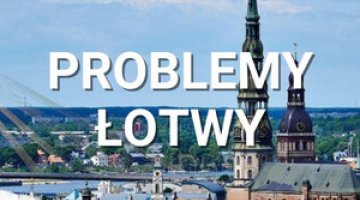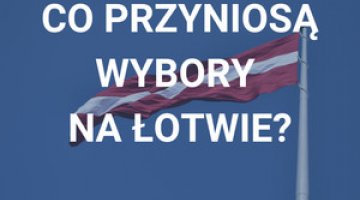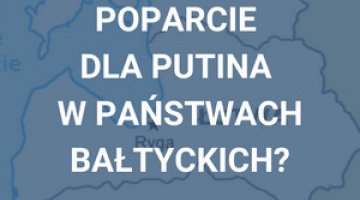Parliamentary elections in Latvia: the fragmentation of the political scene
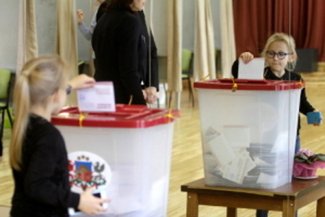
The parliamentary elections in Latvia (6 October) were won by the Social Democratic Party Harmony, which mainly represents an electorate of the country’s Russian-speaking inhabitants. Harmony was chosen by 19.8% of the electorate, which means the loss of a single seat; the party will have 23 in the 100-seat parliament. The next three places were taken by groups appearing in the Saeima of the Republic of Latvia for the first time: the populist and anti-system group Who Does The State Belong To (KPV LV), which was mainly chosen by young voters and Latvian émigrés (14.3%, 16 seats); the New Conservative Party, which has emphasised the fight against corruption (13.6%, 16 seats); and the liberal and pro-EU group For Development/For! (12%, 13 seats). Other groups that managed to cross the 5-percent electoral threshold included the hitherto ruling coalition, the National Alliance All for Latvia - Fatherland and Freedom/LNNK, which will have 13 seats in parliament (11% of the votes). The Union of Greens and Farmers received 11 seats (9.9%), and the liberal New Unity (a coalition of regional parties and the Unity party; the Unity for years had formed the backbone of the ruling coalition in Latvia) won 8 seats (6.7%). Turnout was 54.6%, which is the worst result since Latvia gained independence in 1991.
Commentary
- The parties belonging to the ruling coalition have met with failure. The Union of Greens and Farmers of Prime Minister Māris Kučinskis, who led the ruling coalition in 2016, and to which President Raimonds Vējonis used to belong, lost half of its support compared to the 2014 elections. The Unity, which came second after Harmony in 2014, will have the smallest parliamentary group (now under the name of New Unity), and the nationalists have four fewer deputies than before. The ruling parties have lost much of their public support because they have not responded to expectations of policy changes, including in the social field. Some of them were plunged into scandals, including corruption, and internal divisions.
- The Social Democratic Party Harmony, despite its costly election campaign and a series of attempts to distance itself from its image as a pro-Russian group, will not become a member of the ruling coalition. The only political force that has not ruled out a coalition with it was the new Who Does The State Belong To group (KPV LV), but these two groups will not have enough seats to form a government. The failure of Harmony, which has once again won the parliamentary elections but failed to gain power, will shrink the party’s electorate.
- New groups representing different political profiles have entered parliament: from anti-system populists, through conservatives, to liberals. The fragmentation of parliament means that we should expect lengthy negotiations to form a new coalition. The new majority will have to be based on an alliance of four or even five political forces. The coalition is likely to have a centre-right character with a stronger national component than before. This configuration will mean that compromises, political, ideological and personal, will have to be reached, and will lead to conflicts. Nor should we exclude a harsher course being taken against Russia.
- As he takes the public mood into account President Raimonds Vējonis, a supporter of Latvia’s Euro-Atlantic policy, will probably entrust the mission of forming the government to a candidate associated with one of the new parties in parliament, but not a political debutante. The experienced politicians in the new parties include some former ministers from the governments of the liberal Valdis Dombrovskis: Jānis Bordāns, the leader of the New Conservative Party; and Artis Pabriks from the For Development /For! Party.
Annex
|
The main political forces The parties in the Latvian Parliament |
Election result in 2018 |
Election result in 2014 |
Profile |
|
Social Democratic Party Harmony (SDPS) |
19.8% 23 seats (-1) |
23% 24 seats |
Leftist, pro-Russian, populist, represents the interests of the Russian-speaking minority (approx. 35% of the population, including c. 12% who do not have voting rights) |
|
Who Does The State Belong To (KPV LV) |
14.3% 16 seats |
- |
Populist and anti-system, centred around the person of the popular actor and journalist Artuss Kaimiņš. Calls for the removal of the current ruling elite in the country, and for radical reforms to raise living standards. |
|
New Conservative Party (PCU) |
13.6% 16 seats |
- |
Founded by former officers of the state anti-corruption service KNAB and by some activists of the National Alliance. Centrist-conservative-national, emphasising the fight against corruption. |
|
For Development / For! (A/P) |
12% 13 seats |
- |
Created by some activists of the former Unity centrist party, liberal on economic and ideological issues, pro-EU and pro-NATO. |
|
National Alliance Everything for Latvia - Fatherland and Freedom / LNNK (NA VL-TB / LNNK) |
11% 13 seats (-4) |
16.6% 17 seats |
Brings together the main conservative-nationalist forces, from moderate to ultranationalist. Pro-European, but preserving national interests. Economically liberal. |
|
Union of Green and Farmers (ZZS) |
9.9% 11 seats (-10) |
19.5 21 seats |
Centre-left, agrarian with elements of the Greens’ programme, ideologically conservative, linked to the oligarch Aivars Lembergs. |
|
New Unity (JV) |
6.7% 8 seats (-15) |
21.9% 23 seats (competed alone as Unity) |
Combination of several parties popular in the regions with the Unity party, which is centre-right, economically liberal, conservative on social issues, pro-NATO and pro-European. |
Results for parties which exceeded the electoral threshold of 5%
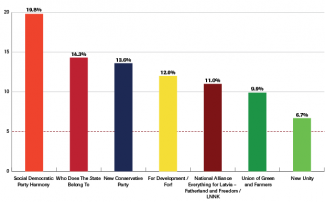

Source: https://www.lsm.lv/



